Practice - Individual Tactics For Attack or Defense
- 1 v. 1
Warm Up 5 - 10 minutes. Activity level
- Mild ramping up. Space: General. 1 - 2 Players per group.

Numbers
Dribbling
The Game
- Each player has a ball and dribbles freely around the grid.
- The coach demonstrates 3 - 4 dribbling or control moves, assigning each a
number.
- As players dribble, the coach calls out a number and the players execute
that particular move.
Coaching Points
- Emphasize heekping head up, change of pace, change of direction, ball
control.
- A good warm-up for any dribbling session
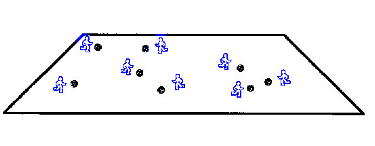
Knock
Out
The Game
- Each player has a ball.
- The object of the game is to protect your own ball while trying to kick the
other player's balls out of the grid.
- If your ball is kicked out, retrieve it, do five push-ups and return to the
game
- The player that is knocked out the least amount of time wins.
Coaching Points
- Shielding sideways on
- Tackling with nearest foot.
- Make sure players do not hang out in the corners.
Small Game 20 - 25 Minutes. Activity
level: Medium progression to high. Space: Defined space "smaller". 3
- 5 players per group.
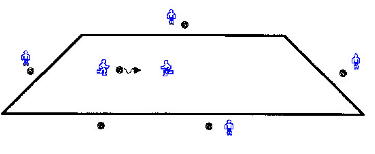
One Versus One
Basics
The Game
- 2 players play 1 v. 1 inside a grid.
- Players outside the grid assist the practice, inserting balls when they go
out and encouraging their teammates to work harder.
- Rotate new players every 2 minutes or so.
Try This Progression
- Attacking player tries to get behind the defender whenever they are in the
grid. Defender tries to gain possession of the ball. This is a continuous flow
game, never stopping. If the attacker beats the defender, they immediately try
to face the defender and beat them again.
- Play where the attacker tries to stop the ball on the endline.
- Play a game with goals on the endline to shoot through.
Coaching Points
Attackers:
- Keep balanced, short steps, knees bent.
- Always try to face defender, and take them on.
- Shield ball for possession, sideways on.
- When taking players on, drive towards leading foot. First fake the other.
- When attempting to face defender, make a "self-pass" to get away.
Defenders:
- Keep balanced, short steps, knees bent, never square to attacker
- Try to channel attacker to sideline.
- Tackle after touch is made.
- Don't lunge.
- Angle of approach, speed of approach.
- Make play predictable.
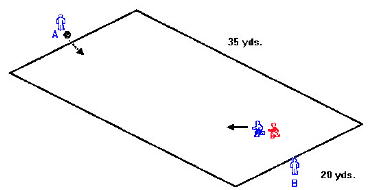
1 + 1 v. 1
+ 1
The Game
- The object of this game is to get the ball from one taget "A" to
the other "B" without losing possession.
- Each time this is done, it is worth one goal.
- The attacking team keeps this sequence up until possession is lost (ie.
they can score as much as possible).
- If the ball goes out of bounds, it belongs to the other team.
- Targets "A" & "B" may move along their line.
Coaching Points
- In attack
- Encourage combination play between the players.
- Have targets look for the player farthest away.
- Check away from the ball to create space for yourself, check back for the
ball at angles.
- Receive the ball sideways on whenever possible.
- In defense:
- Make attackers play the ball back whenever possible.
- keep the play in front of you.
- Never get flat with each other.
- Take away options for the attackers, make the play predictable.
Variations
- Limit target players to one touch.
- Limit field players to two touches.
- Do not allow ield players to play the ball back to the target they received
it from.
- Play 2 v. 2 in the middle or 3 v. 3, size accordingly.
- Make field players play it to each other at least once before they make a
goal.
Team Game 30 Minutes plus. Activity
level: High. Space: Defined for the game = larger space. 7 - 11 players per
team.
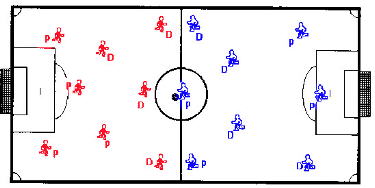
Passers &
Dribblers Game
The Game
Two equal teams on a regulation field. Divide each team: half are dribblers (with a maximum of 5 touches before they
shoot or pass) and passers (maximum of two
touches). All soccer rules apply. If dribbler or passer breaks the restrictions,
ball goes to the other team. Use different color pinnies to identify dribblers
and passers.
Coaching Points
- Each team must organize passers and dribblers so they are in the best
positions on the field.
- Make sure to rotate passers and dribblers.
- Dribblers must control the ball, and dribble to shield if there are too
many players around them or dribble to goal and beat opposing defenders.
- Passers must receive the ball on their first touch and make good passes
with the next touch. Don't allow them to just kick the ball away. It should be
passed to a teammate.
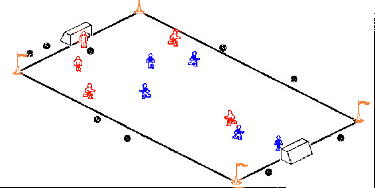
Match
Conditions
The Game
- An even sided game with full goals that is played just like the real game
but not necessarily with an 11 v. 11 format.
- The coach then observes if the training has had any effect on the players'
ability to meet the demands of the game.
- Coaching points can still be made but the coach focuses his comments on the
theme of the practice.
- If the session was a technical session, the coach focuses on the players
body and sees if it is meeting the demands of the game technically.
- If the session was tactical in nature, the coach focuses on what the player
is seeing and focuses on whether or not the player is interpreting the visual
clues correctly or making the correct decisions based on what is seen.
Warm Down 5 - 10 Minutes. Activity
level: Low ramping down. Space: General, No specific boundaries. 1 - 2 players
per group.
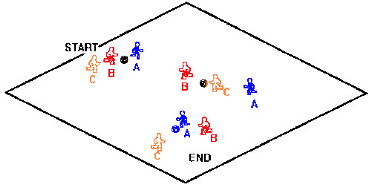
Snake
Snake Dribble
Divide players into groups of three or four. Middle player (B) starts with
the ball. Player B must try to follow the head of the snake, Player A. Player C
follows Player B. On command, B steps on ball and becomes new head of snake.
Player A goes to the end and Player C now has the ball in the middle.
Coaching Points
- Head of snake should move at different speeds, including stopping.
- Encourage moving in many different directions.
- Middle player must keep eyes up to see the head of the snake.
- Encourage use of man different surfaces of the feet in contact with the
ball.
Practice List







